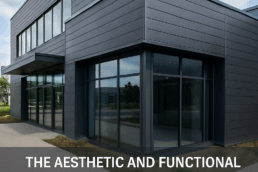Architectural sheet metal plays a vital role in modern construction. It offers both aesthetic appeal and functional benefits. This post explores the essence of architectural sheet metal, its applications, and why it is crucial for contemporary design.
What is Architectural Sheet Metal?
Architectural sheet metal involves the use of metal sheets in building construction for decorative and structural purposes. These sheets are crafted from various metals, each chosen for their unique properties and suitability for specific project requirements. Common materials include:
- Aluminum: Lightweight and resistant to corrosion, making it ideal for exterior applications.
- Copper: Known for its longevity and distinctive appearance that evolves over time.
- Zinc: Offers a self-healing patina that provides a long-lasting and attractive finish.
- Steel: Available in different forms such as stainless and galvanized, prized for its strength and versatility.
Custom sheet metal is not just about the material itself but also about how it is used to enhance both the functionality and visual appeal of a building.
Applications of Architectural Sheet Metal
Architectural sheet metal is used in various applications, each contributing to the overall integrity and aesthetics of a structure. Key applications include:
Roofing and Cladding
One of the most common uses of architectural sheet metal is in roofing and cladding. Metal roofs are renowned for their durability and ability to withstand harsh weather conditions. Cladding, on the other hand, provides an extra layer of protection while significantly enhancing the building’s visual appeal. The sleek, modern look of metal cladding can transform a mundane structure into an architectural masterpiece.
Gutters and Downspouts
Effective water drainage is crucial for any building, and architectural sheet metal plays a significant role in this aspect. Gutters and downspouts made from durable metals ensure efficient water management, protecting the building from water damage. These elements are not only functional but can also be designed to complement the overall architectural style.
Benefits of Architectural Sheet Metal
The popularity of architectural sheet metal in construction is due to its numerous benefits, which include:
Durability
Metal sheets are highly resistant to harsh weather conditions, including extreme heat, cold, and heavy rainfall. This resilience translates to a longer lifespan, reducing the need for frequent repairs or replacements. Materials like copper and zinc even develop protective patinas over time, enhancing their durability.
Versatility
Architectural sheet metal can be molded into various shapes and sizes, making it suitable for unique and complex designs. This versatility allows architects to experiment with innovative structures and styles, pushing the boundaries of traditional construction methods.
Aesthetics
The sleek, modern look of metal sheets adds a contemporary touch to any building. Whether used as roofing, cladding, or decorative elements, metal sheets offer a clean and polished appearance that complements modern architectural trends. The range of finishes and colors available further enhances their appeal, allowing for customization to suit specific design preferences.
Architectural sheet metal is a cornerstone of modern construction, blending durability with aesthetic appeal. Its applications in roofing, cladding, and drainage systems highlight its importance in enhancing both functionality and design.
For your next project, consider incorporating architectural sheet metal to take advantage of its numerous benefits and elevate your building’s overall look and performance.
At C&J Metal Products, our team can meet complex architectural sheet metal fabrication requirements. Feel free to contact us for more information.



